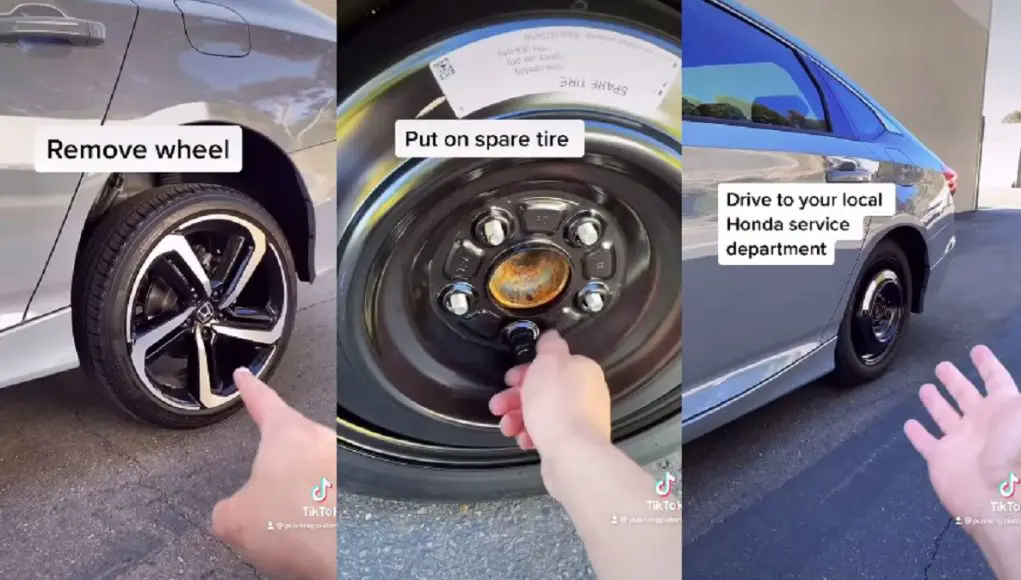Compact spare tires are only meant for you to get back home and/or to the nearest tire repair shop.
If you drive, sooner or later you’re going to get a flat tire.
While many car manufacturers have taken out the spare tire and replaced it with a can of tire slime and an inflator, many cars still have spare tires.
Now, I know money is tight out and, with a spare tire on, besides looking dorky as heck, your car, for the most part, accelerates, brakes, and steers just like it did before.
So, how long can you realistically drive on that compact spare?
Like, for real, for real?
Here’s what the manufacturer recommends, the reasoning behind it, and my .02 how long I’d personally feel comfortable driving on it.
What your manufacturer recommends.
Typical spare tire advice reads like this one I’ve posted below from a 2023 Honda Civic, don’t exceed 50 MPH and replace the spare tire with a full size as soon as possible.

How long is “as soon as possible.”
It means exactly that, as soon as possible.
Your car manufacturer and the spare tire maker have engineered and designed the spare tire to last as long as reasonably possible (within a distribution of spare tire users) and then some (to account for extreme cases and the inevitable lazy car owner.)
Does it mean to the next repair shop?
To home and just around town for the weekend until your paycheck hits your bank account, and then you can withdraw money to buy a new tire three days later?
Or how about you’re in the middle of nowhere, and you need to drive 300 miles out of the desert, keeping speeds below 50 MPH, until you can get to the nearest repair shop?
Yes, yes, and yes.
All of those are acceptable use cases for using a spare tire until you can replace it with a full spare as soon as possible.
Why can’t I drive as far on a compact spare compared to a normal-sized tire?
Simply put, compact spare tires will wear out faster and are not as safe to drive on compared to a normal-sized tire.
A blog from Discount Tire/ America’s Tire spells it out for us.
“Spare tires do not offer much tread because they are meant to only get you to the next service station. Plus, because of their smaller overall diameter, they actually spin several times faster than your standard tire. All of this means they can heat up exponentially faster and wear out sooner.”
How long I’d drive on a spare tire if I really wanted to stretch it out.
First, I’m going to tell you how long I’d feel comfortable driving on a spare given a set of conditions.
Then, I’m going to tell you the cheapest and still relatively safest way to replace your flat one. Safer than your spare tire, at least.
I would personally only use a spare tire for (1) long freeway trip, keeping speeds under 50 MPH.
After that one freeway trip, I would not use my car on the freeway with that same spare tire on, again.
But, if I needed to use my car with a spare tire and I only plan to drive around town with trips less than 10 miles, quite honestly I’d feel comfortable driving for several weeks on it with these rules you probably should follow, too if you plan to do this.
- Only drive up to the speed limit (45 MPH or less) and in the right lane.
- Do not make any quick turns or corner like a jacka**.
- Check and ensure the tire pressure is where it’s supposed to be (often 60+PSI.)
- As mentioned, freeway trips or drives longer than 10 miles are strictly forbidden.
Now, if your full sized tire got punctured on a part that’s on the sidewalls or within an inch of the sidewall, you cannot repair it with a plug kit.
It’s essentially ruined, and the cheapest thing you can do is go to a tire shop and get it replaced with a good (less than 6 years old) used tire.
Google how much a new tire is because sometimes even the cheapest new tire at Walmart is the same price, if not cheaper, than a used tire, so keep that price in mind when buying a used one. (I recently needed to replace a small tire, a 185/65/14, and America’s Tire sells them new for $49, whereas the tire repair shop quoted me $68 for a used one.)
However, if the puncture is not on the sidewalls and in the middle, width section of the tire, you’re in luck.
Simply buy a $5 plug kit from Wal-Mart, watch a Youtube video (this one’s a good one) on how to use it, and plug it yourself.
Be sure that you do this where you have an air source like your neighbor’s air compressor, at a gas station, or even a bike pump will do in a pinch.
People say you can’t drive on a plugged tire like normally, but personally I’ve driven on plugged tires for thousands of miles, no problem.
So, that’s how far I’d drive on a compact spare, one freeway trip and comfortably several days (if not weeks) just around town, driving extra cautiously.
My official advice is to change that compact spare tire with a full size tire as the manufacturer recommends, as soon as possible.




